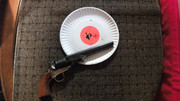Dutch Schoultz said:
Griz,
So is powder sold by weight or volume?
Would an unopened "pound" of off weigh the same as an unopened can of 3fff?
Enquirung minds can be a pain”¦
Dutch Schoultz
OK, back to the scale. I have a very sensitive USPS calibrated postage scale, and:
Placed an empty GOEX 2f bottle on the scale and zeroed. Placed a full one on the scale, net is exactly one pound. So That's by weight.
Replicated the effort with a Swiss 3f bottle.
Net is exactly One pound.
I had to dump a full pound of 2f Old Ensford into a Tupperware bowl that had been zeroed on the scale.
Net is exactly one pound.
I repeated with a bottle of Old Ensford 3f.
Net is exactly one pound.
All containers are marked "Net Weight 1 pound" or "Net Weight 16oz"
Conclusion:
Black powder is sold by the pound.
A pound is exactly 7000 grains - BY WEIGHT, not by volume. Powder measures are not accurate devices to do precision loading with. If you want precision, weigh your charges.
For what I do with black powder, a volumetric measure is more than close enough. I have calibrated my sights for specific charges loaded with my adjustable measure. At some point, I will likely get another measure, and will carefully check it before attempting to duplicate my current loads. I can say that the loads I currently shoot are nowhere near the max the guns can handle, so I feel safe in loading the way I do.
This has been an interesting foray into loading black powder. What I thought was so radically different from smokeless, is really not different at all. It's just the lack of brass and a closed breech that makes it different, and fun.
What would be interesting, if anyone has a graduated lab cylinder, would be to dump a pound of each different powders into it and see how much different the brands are from each other, volume wise...






